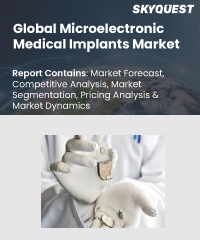
Report ID: SQMIG35A2689

Report ID:
SQMIG35A2689 |
Region:
Global |
Published Date: February, 2024
Pages:
157
|
Tables:
64 |
Figures:
75
Microelectronic Medical Implants Market size was valued at USD 28.04 Billion in 2022 and is poised to grow from USD 29.91 Billion in 2023 to USD 50.26 Billion by 2031, at a CAGR of 6.70% during the forecast period (2024-2031).
The global microelectronic medical implants market has been experiencing significant growth and is poised for further expansion. Several key drivers have contributed to the market's growth. Firstly, advancements in microelectronics and nanotechnology have enabled the development of smaller, more efficient, and sophisticated implants, making them less invasive and more effective in treating various medical conditions. These technological breakthroughs have enhanced patient outcomes, reduced complications, and improved the overall quality of life for individuals with chronic illnesses. Secondly, the increasing prevalence of chronic diseases and the aging population have played a pivotal role in driving the demand for microelectronic medical implants. Conditions such as cardiovascular disorders, neurological diseases, hearing impairments, and chronic pain are becoming more prevalent globally. Microelectronic implants offer viable solutions to manage and treat these conditions, driving the market's expansion. Additionally, the rising trend of wearable medical devices and remote patient monitoring has further accelerated the adoption of microelectronic medical implants. Integration of these implants with data collection and communication technologies allows healthcare professionals to access real-time patient data, enabling personalised and timely interventions. Despite the market's growth opportunities, several challenges need to be addressed. The high cost of research, development, and manufacturing of microelectronic medical implants remains a significant obstacle, hindering access to these cutting-edge technologies for some patient populations and healthcare systems.
Cost containment strategies and greater investment in research and development are necessary to address this challenge. Moreover, ensuring the security and privacy of patient data is a critical concern with the increasing connectivity of medical implants. Cybersecurity threats and potential breaches could compromise patient safety and undermine public trust in these technologies. Rigorous cybersecurity measures and regulatory compliance are imperative to safeguard patient information and maintain the integrity of microelectronic medical implants. Furthermore, the stringent regulatory approval processes set by governing bodies such as the U.S. Food and Drug Administration (FDA) and the European Medicines Agency (EMA) can cause delays in bringing new products to market. Companies in the microelectronic medical implants industry must navigate complex regulatory landscapes to gain approval for their devices, which can be a time-consuming and resource-intensive process.
US Microelectronic Medical Implants Market is poised to grow at a sustainable CAGR for the next forecast year.
Our industry expert will work with you to provide you with customized data in a short amount of time.
REQUEST FREE CUSTOMIZATIONWant to customize this report? This report can be personalized according to your needs. Our analysts and industry experts will work directly with you to understand your requirements and provide you with customized data in a short amount of time. We offer $1000 worth of FREE customization at the time of purchase.

Report ID: SQMIG35A2689